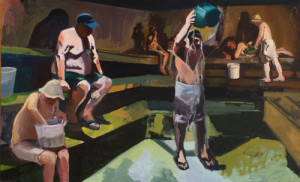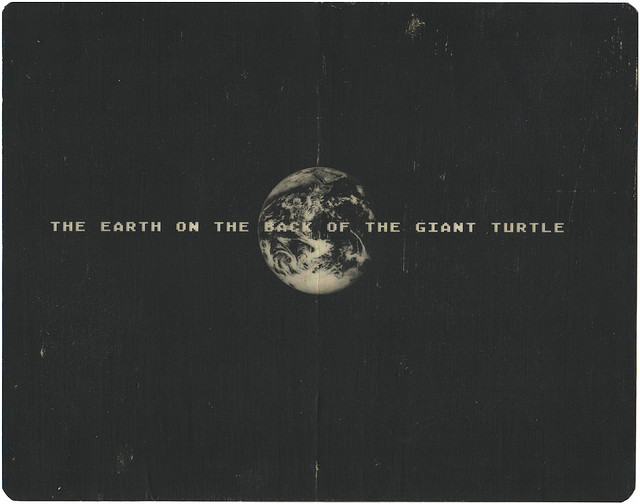Hollis Brown Thornton, “The Earth on the Back of the Giant Turtle”
Project Space: Megan Euker
June 27th – August 16th, 2008
Artist Reception: Friday, June 27th, 6-9 pm
 Linda Warren Gallery is proud to announce the opening of “The Earth on the Back of the Giant Turtle”—Hollis Brown Thornton’s first solo exhibition in the gallery. The show’s title, which also serves as the name for each individual piece in the exhibit, references a creation myth – an explanation and belief by certain cultures (including several Native American tribes) of Earth’s origin and the nature of the universe. The turtle theory is, of course, just one amongst many and may seem ridiculous to some; however, the notion of an ever-changing reality, of infinite perspective and possibility that evolves both by the random influences of region, culture and religion, as well as the constants of time, life and death, form the crux of Thornton’s artistic pursuit. It embodies numerous meanings, ideas and perspectives just as mankind’s multifaceted understanding of reality. In addition, it is both a metaphor and exploration of the commingling of realities, including “virtual reality” and the ever-increasing influence of computers in contemporary times.
Linda Warren Gallery is proud to announce the opening of “The Earth on the Back of the Giant Turtle”—Hollis Brown Thornton’s first solo exhibition in the gallery. The show’s title, which also serves as the name for each individual piece in the exhibit, references a creation myth – an explanation and belief by certain cultures (including several Native American tribes) of Earth’s origin and the nature of the universe. The turtle theory is, of course, just one amongst many and may seem ridiculous to some; however, the notion of an ever-changing reality, of infinite perspective and possibility that evolves both by the random influences of region, culture and religion, as well as the constants of time, life and death, form the crux of Thornton’s artistic pursuit. It embodies numerous meanings, ideas and perspectives just as mankind’s multifaceted understanding of reality. In addition, it is both a metaphor and exploration of the commingling of realities, including “virtual reality” and the ever-increasing influence of computers in contemporary times.
Thornton’s process of creating his art is key to understanding its conceptual underpinnings. Visible throughout the oeuvre is Thornton’s employment of a pigment transfer process that activates, via its combined use of control and chance, a very tangible process of creation and destruction. Formally, the works unveil and mirror the issue of investigation—man’s eternal quest to understand reality and the inherent limitations of that search. Not ironically do the materials of this practice, including carbon, (from the black transfer pigment), calcium (in the gesso and marble dust) and water (used to remove the paper from the transfers), represent the human body’s main ingredients.
Outer space, referenced in several of the works, represents one direction of man’s continual probing. In one work, Thornton compositionally places the Earth squarely at the center of the universe – a once commonly held belief now known to be false. In another piece, a lone astronaut appears literally lost in space—floating off the edge of this relatively empty, pictorial cosmic landscape. However, what today may be called “dark matter” could tomorrow be something else. Thornton employs the Space Invader “icon” in several works to suggest the origins of “virtual reality,” giving its place in history a nostalgic and new significance as well as alluding to belief systems preoccupied with doomsday scenarios.
Family photographs are utilized as the subject of other works. Representative of frozen moments in time, these figures are the indefatigable questioners of creation. Thornton manipulates these images in Photoshop before transferring them onto the pages of an art journal – to destabilize them and reinforce the idea of transformation.
In Thornton’s large-scale paintings, what we perceive to be “mountains” is actually the back of an Alligator Snapping Turtle, a giant creature indigenous to the southeast United States. The mountains, suggestive of Egyptian pyramids, are simplified and at times dissolving. Their abstract nature reflects ambiguous, all encompassing ideas, such as creation and different realities, and their color, similar to that of melting glaciers, reflects the current reality of global warming. Thornton explores the line—specifically, lines created by dripping paint. These lines transform subtly and, at times, dramatically as they travel across the entire surface of the canvas. The uninhibited movement of the lines not only conveys the impossibility of controlling one’s environment, but also the complexity of reality and humanity’s constantly altering perspective of reality.
Hollis Brown Thornton was born in 1976 and raised in Aiken, South Carolina. In the spring of 1999, Thornton received his BFA from the University of South Carolina in Columbia, SC. After working for a few years in Chicago, Thornton realized that the South was a significant element of his work and returned to Aiken in August of 2005, where he is currently working as a full-time artist.
 On display in the Project Space are new paintings by Chicago-based artist Megan Euker. Euker’s interest in a ritualistic human interaction has been focused most recently on making paintings about cultural-specific water-immersion and bathing rituals. Currently, she is painting scenes of people bathing in a Russian Bath house in Chicago. This work is a natural progression from previous paintings of people bathing in sulfuric springs in Italy, and romantic couples bathing in their homes. Through the way she composes the picture and constructs the gesture of the figure, she describes an intimate moment between a couple or community of strangers. Although the work is very place and cultural specific, it is not recognizably so — the rituals are quite universal and could take place anywhere from Rome to Morocco to New Jersey.
On display in the Project Space are new paintings by Chicago-based artist Megan Euker. Euker’s interest in a ritualistic human interaction has been focused most recently on making paintings about cultural-specific water-immersion and bathing rituals. Currently, she is painting scenes of people bathing in a Russian Bath house in Chicago. This work is a natural progression from previous paintings of people bathing in sulfuric springs in Italy, and romantic couples bathing in their homes. Through the way she composes the picture and constructs the gesture of the figure, she describes an intimate moment between a couple or community of strangers. Although the work is very place and cultural specific, it is not recognizably so — the rituals are quite universal and could take place anywhere from Rome to Morocco to New Jersey.
Megan Euker received her BFA and MFA from The School of the Art Institute of Chicago in 2005 and 2007 respectively. Amongst other notable achievements in her emerging career, she has most recently been awarded a Fulbright Scholarship in Italy for 2008-2009. This program is partially supported by a grant from the Illinois Arts Council, a state agency.
